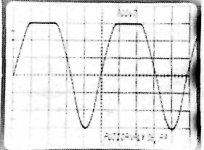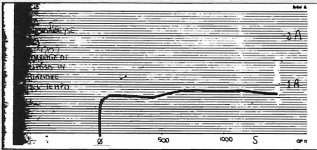Hello,
If the fuse blows away, the output transistors have burnt before it.
For inadequacy of the fuse or circuit? 😕
Continuing in the transposition of Montanucci's considerations ...
“To operate in class A up to 50 watts on 8 Ohm, a push-pull stage should be theoretically polarized with a idle current of 1.77 A, even if the non-linear trend of the polarization voltage prevents the power off of the finals even with slightly lower polarizations (10%). In the A9, normally, the idle current is 0.9 A, which translates into a maximum power of 15 watts in class A on 8 Ohm [see first image] or, reasoning in terms of the minimum impedance module on which there is no switching off of the finals for the maximum rated voltage (20 volts), in a transition module of 14.5 Ohm.
As in many other cases, (...) , rather than class A (...) it would be necessary to speak of high polarization or a idle current at least one order of magnitude higher than that of conventional amplifiers: apart from not fully respecting the announced characteristics, this nevertheless allows to improve the performance in terms of intrinsic linearity, very important in an amplifier with moderate feedback, and of less variation of the operating temperature.
What is surprising is that, unlike other sub-polarized class A amplifiers, the electrical sizing and the efficiency of the heat sinks would have allowed to raise the idle current; probably considerations related to reliability have recommended a certain moderation (the power dissipated by a final decreases linearly with the temperature and, in this case, the safety in anomalous situations is guaranteed only by the energetic dimensioning). In any case, from the circuit analysis the idle current adjustment trimmer appears clearly recognizable which, for operation in class A up to 50 watts on 8 Ohm, should be adjusted - when hot - so as to impose a voltage of 0, 37/0.39 volts on each emitter resistance but I don't want to instigate to violate the warranty conditions!
One aspect in which the A9 stands out positively compared to other class A amplifiers is that of thermal stability, linked to the configuration of the final stage and to mechanical assembly (…) ; a final stage emitter follower is inherently stable on the thermal plane when the following conditions occur:
1) the polarizing stage is made with a transistor;
2) the thermal resistance between all interested chips is zero;
3) the voltage drop on the local voltage resistors of the finals with respect to the global polarization voltage of the final stage is negligible;
4) the Vbe of the polarizing transistor is identical to the Vbe of pilots and finals.
The A9 satisfies all these points well with the partial exception of the third, due to the high polarization (0.42 volts drop on the emitter resistors, 2.6 volts total polarization), and therefore has a small excess of thermal correction with increasing temperature. The demonstration is in the image that shows the trend of the current: the A9 goes to full operation almost immediately; the significant increase in temperature that follows a few minutes after switching on causes only a small and negligible drop in the bias current.”
The engineer Fabrizio Montanucci is an esteemed and appreciated technician who has spent his life in the laboratory for the most prestigious Italian specialized magazines, Suono (in n.197 of 1989 he reviewed the couple C900/A9 Audioanalyse) and, currently, Audio Review.
On the basis of his considerations, a dear friend who owned the electronic pair (now only the amplifier is left), adjusted the quiescent current to obtain the full functioning of the A9 in class A with great satisfaction. The appliance has always worked perfectly and has never experienced malfunctions. And even though he has now turned towards active loudspeakers, he occasionally puts it back in operation with a pair of Acoustical Linea ... until the other day when he saw that the plastic of the fuse covers had deteriorated!
Now, probably, it's up to change the fuse holders entirely ... 🙁
“To operate in class A up to 50 watts on 8 Ohm, a push-pull stage should be theoretically polarized with a idle current of 1.77 A, even if the non-linear trend of the polarization voltage prevents the power off of the finals even with slightly lower polarizations (10%). In the A9, normally, the idle current is 0.9 A, which translates into a maximum power of 15 watts in class A on 8 Ohm [see first image] or, reasoning in terms of the minimum impedance module on which there is no switching off of the finals for the maximum rated voltage (20 volts), in a transition module of 14.5 Ohm.
As in many other cases, (...) , rather than class A (...) it would be necessary to speak of high polarization or a idle current at least one order of magnitude higher than that of conventional amplifiers: apart from not fully respecting the announced characteristics, this nevertheless allows to improve the performance in terms of intrinsic linearity, very important in an amplifier with moderate feedback, and of less variation of the operating temperature.
What is surprising is that, unlike other sub-polarized class A amplifiers, the electrical sizing and the efficiency of the heat sinks would have allowed to raise the idle current; probably considerations related to reliability have recommended a certain moderation (the power dissipated by a final decreases linearly with the temperature and, in this case, the safety in anomalous situations is guaranteed only by the energetic dimensioning). In any case, from the circuit analysis the idle current adjustment trimmer appears clearly recognizable which, for operation in class A up to 50 watts on 8 Ohm, should be adjusted - when hot - so as to impose a voltage of 0, 37/0.39 volts on each emitter resistance but I don't want to instigate to violate the warranty conditions!
One aspect in which the A9 stands out positively compared to other class A amplifiers is that of thermal stability, linked to the configuration of the final stage and to mechanical assembly (…) ; a final stage emitter follower is inherently stable on the thermal plane when the following conditions occur:
1) the polarizing stage is made with a transistor;
2) the thermal resistance between all interested chips is zero;
3) the voltage drop on the local voltage resistors of the finals with respect to the global polarization voltage of the final stage is negligible;
4) the Vbe of the polarizing transistor is identical to the Vbe of pilots and finals.
The A9 satisfies all these points well with the partial exception of the third, due to the high polarization (0.42 volts drop on the emitter resistors, 2.6 volts total polarization), and therefore has a small excess of thermal correction with increasing temperature. The demonstration is in the image that shows the trend of the current: the A9 goes to full operation almost immediately; the significant increase in temperature that follows a few minutes after switching on causes only a small and negligible drop in the bias current.”
The engineer Fabrizio Montanucci is an esteemed and appreciated technician who has spent his life in the laboratory for the most prestigious Italian specialized magazines, Suono (in n.197 of 1989 he reviewed the couple C900/A9 Audioanalyse) and, currently, Audio Review.
On the basis of his considerations, a dear friend who owned the electronic pair (now only the amplifier is left), adjusted the quiescent current to obtain the full functioning of the A9 in class A with great satisfaction. The appliance has always worked perfectly and has never experienced malfunctions. And even though he has now turned towards active loudspeakers, he occasionally puts it back in operation with a pair of Acoustical Linea ... until the other day when he saw that the plastic of the fuse covers had deteriorated!
Now, probably, it's up to change the fuse holders entirely ... 🙁

